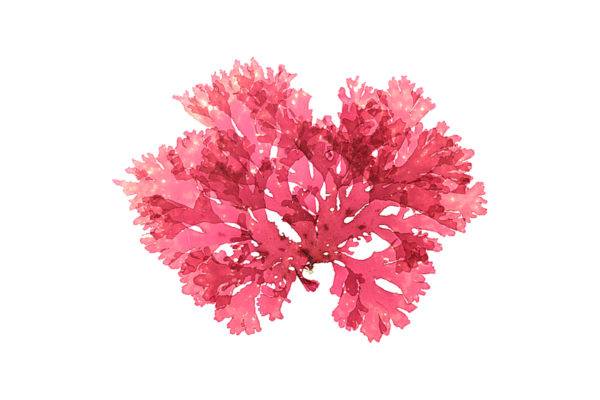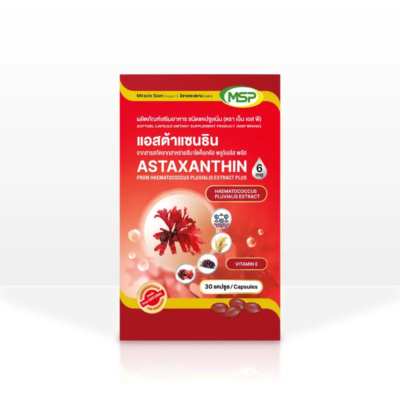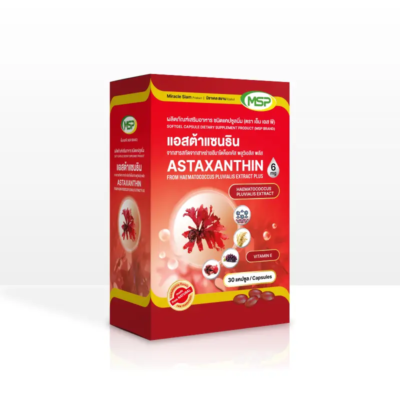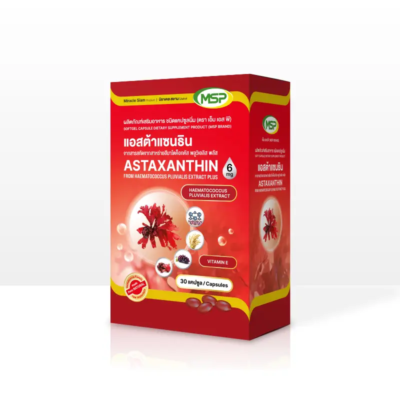Astaxanthin
Astaxanthin is a lipid–soluble, reddish–orange pigment that belongs to a group of carotenoids called xanthophylls, which includes β–cryptoxanthin, canthaxanthin, lutein and zeaxanthin [1]. It is obtained from primary sources such as higher plants; microscopic phytoplankton algae Haematococcus pluvialis, Chlorella zofingiensis, Chlorococcum sp.; and some microorganisms, i.e., Xanthophyllomyces dendrorhous (anamorph Phaffia rhodozyma) yeasts and bacteria such as Mycobacterium lacticola, Brevibacterium, Agrobacterium aurantiacum, Alcaligens sp. strain PC–1. and Paracoccus carotinifaciens [2]. Although plants, bacteria, and microalgae can also produce astaxanthin, the chlorophyte alga Haematococcus pluvialis is considered to have the highest capacity to accumulate astaxanthin [3].

The structure of astaxanthin is similar to β–carotene but it has 40 times stronger antioxidant activity since its polar ionone rings on both ends can quench free radicals and other reactive oxygen species (ROS), and the thirteen conjugated double, polyunsaturated bonds can remove high energy electrons. Its amphipathic structure with polar–nonpolar–polar characteristics allows astaxanthin to be inserted into the bilayers of cell membranes, confines lipoperoxidation promoters to penetrate across the lipid bilayer and thus reduces peroxidation–caused damages [4].
Due to astaxanthin’s structural characteristics, it can pass through the blood-brain barrier to the brain and be absorbed from the small intestine into the plasma and erythrocytes, including the epidermis and dermis, and the skin [5].
Numerous studies have shown that astaxanthin’s exceptional antioxidant potential may be used in the prevention and treatment of diseases related to reactive oxygen species, such as Type 2 diabetes, artherosclerosis, neurodegenerative diseases, and eye diseases [2]. In addition, astaxanthin has several essential biological functions, including pigmentation, protection against ultraviolet (UV), immune response, reproductive capacity, stress tolerance, and protection against oxidation of macromolecules [3].

Health Effects of Astaxanthin
Skin-Protective Mechanisms
Antioxidant Activity
The aging process and cutaneous damage in humans are greatly influenced by oxidative stress. Both intrinsic (chronological) and extrinsic (photo-) aging have mechanisms that involve the generation of ROS as a result of oxidative metabolism and exposure to sun ultraviolet (UV) light, respectively. Consequently, the generation of ROS is a key factor causing skin aging. Oxidant events of skin aging involve damage to DNA, the inflammatory response, reduced production of antioxidants, and the generation of matrix metalloproteinases (MMPs) that degrade collagen and elastin in the dermal skin layer leading to the formation of wrinkles and loss of skin elasticity [3, 4].
Astaxanthin has attracted the attention of researchers, because of its potent antioxidant activity and its unique molecular and biochemical messenger properties with potential for treating and preventing skin diseases. In comparison studies exploring the photoprotective properties of carotenoids, astaxanthin was found to have a higher antioxidant capacity in human dermal fibroblasts than canthaxanthin and β–carotene.
In particular, astaxanthin regulates the expression of oxidative stress-responsive enzymes such heme oxygenase-1 (HO-1), a sign of oxidative stress and a regulatory mechanism involved in the cell’s defense against oxidative damage, and prevents the production of ROS. HO–1 is regulated via various stress–sensitive transcription factors, including nuclear factor erythroid 2–related factor (Nrf2), which binds to antioxidant response elements in the promoter regions of enzymes of the detoxifying metabolism.
Several authors demonstrated that astaxanthin activates the Nrf2/HO–1 antioxidant pathway by generating small amounts of ROS. Consistent with these studies, observed that astaxanthin upregulated Nrf2 expression in irradiated cells.
Furthermore, in the presence of astaxanthin, irradiation cells markedly increased the Nrf2-targeted proteins HO-1, superoxide dismutase 2 (SOD2), catalase (CAT), and glutathione peroxidase 1 (GPX1), as well as several other antioxidative enzymes. As a result, astaxanthin exerts strong antioxidant effects not only by directly scavenging free radicals but also by triggering the cellular antioxidant defense system via altering the Nrf2 pathway [3]. Astaxanthin may also inhibit the synthesis of lipid peroxides, so assisting in preserving the sebum content that naturally declines with age, avoiding the oxidation of sebum lipids, and reducing rough skin and the odor associated with aging [4].

Anti-Inflammatory Properties
Astaxanthin: The mechanism by which continued oxidative stress causes chronic inflammation, which in turn mediates the majority of chronic diseases like neurodegeneration, cancer, and skin damage, has been extensively studied over the past 20 years. It is widely known that various proinflammatory markers in skin are increased as a result of UV exposure.
Keratinocytes are essential in the photodamage response after UV exposure by releasing proinflammatory mediators. It has been demonstrated that astaxanthin treatment prevents the deleterious effects of UV by decreasing UV–induced reactive nitrogen species production, inflammatory cytokine expression, and apoptosis in keratinocytes.
Inducible nitric oxide (iNOS) and cyclooxygenase (COX)-2 levels were significantly reduced by astaxanthin, and it also decreased the release of prostaglandin E2 from keratinocytes after UV irradiation [3].
Effects on Skin Damage
Collagen, elastin, and glycosaminoglycans (GAGs) are the most significant and prevalent components of the dermal extracellular matrix (ECM). Changes in these structures are seen in both intrinsic and extrinsic aging. These alterations result in wrinkle formation, dryness, loss of tensile strength and rebound capability, and slowed wound healing. Additionally, UV-induced ROS stimulate the synthesis of MMPs that are responsible for the degradation of ECM, particularly those that may completely destroy collagen. In vitro, astaxanthin effectively suppresses cell damage caused by free radicals and induction of MMP–1 in skin after UV irradiation. Some similar studies also reported that astaxanthin inhibited the expression of MMPs in different cells, including macrophages and chondrocytes. The ECM at the wound site dramatically reorganizes during wound healing. It has been demonstrated that astaxanthin is an effective compound for accelerating wound healing in full–thickness dermal wounds in mice. Wounds treated with astaxanthin had considerably higher levels of biological indicators for wound healing like basic fibroblast growth factor (bFGF) and collagen type I α 1 (Col1A1) [3].

Cardiovascular and Metabolic Syndrome
Astaxanthin has three stereoisomers: (3R,3’R), (3R,3’S) and (3S,3’S). Disodium disuccinate astaxanthin (DDA), a synthetic derivative of astaxanthin composed of the three stereoisomers, has been created by Cardax Pharmaceuticals. DDA has been used predominantly in experimental myocardial ischaemia–reperfusion models. In order to determine whether prior DDA treatment was effective in lessening myocardial damage, the myocardial ischemia-reperfusion paradigm has been applied to a variety of animals, including the rat, rabbit, and dog.
After four days of intravenous DDA therapy at dosages of 25, 50, and 75 mg/Kg/d, myocardial infarct size was significantly reduced in Sprague-Dawley rats. The effects were dose related, with less myocardial damage at higher doses [6].
The oxidative stress biomarkers including malondialdehyde, isoprostanes, superoxide dismutase, and total antioxidant capacity were all decreased in 23 obese and overweight healthy people when astaxanthin was taken at doses of 5 and 20 mg/day. In another study, astaxanthin enhanced apolipoprotein B, oxidative stress indicators, and low-density lipoprotein cholesterol in 27 obese and overweight patients. In an uncontrolled, open-label clinical study, 17 volunteers who were at risk of developing the metabolic syndrome received astaxanthin 8 mg twice daily.
Participants who received astaxanthin experienced a significant increase in adiponectin levels as well as significant decreases in HbA1c and tumor necrosis factor–alpha (TNF–α). Thus, astaxanthin shows promise at improving a range of metabolic factors that may have benefits in cardiovascular risk reduction [6].
Diabetes–protective activities
Diabetes mellitus (DM) leads to high blood sugar and is associated with oxidative stress and inflammation. Activating the NF–κB pathway, generating VEGF to prevent microvascular damage, and anti-apoptotic activity via modulation of MAPKs and PI3K/Akt pathways all contribute to the effectiveness of astaxanthin in the treatment of diabetic retinopathy and diabetic neuropathy. Furthermore, astaxanthin inhibited NF–κB translocation, transforming growth factor–beta (TGF–β) generation, inflammation, and fibrosis. In addition, due to its ability to reduce inflammation and oxidative stress through the NF–κB pathway and vasoconstriction, astaxanthin has demonstrated effectiveness in treating cardiovascular problems related to diabetes [7].
Neuroprotective Activities
The central nervous system (CNS) is one of the most important systems in the human body and it contains billions of neuronal and glial cells. The blood–brain barrier (BBB) is a selectively permeable barrier between capillaries and the brain that isolates the CNS from other systems of the body. This barrier is crucial for maintaining brain homeostasis and protecting the neuronal environment from harmful materials. However, the BBB occasionally prevents the transportation of therapeutic agents to the CNS for the treatment of neurological disorders.
As mentioned previously, astaxanthin is a lipid–soluble that may penetrate the BBB, which is essential for the treatment of neurological diseases. There is a study found that astaxanthin accumulates in the hippocampi and cerebral cortexes of rat brains after single and repeated dietary ingestion. The accumulation of astaxanthin in the cerebral cortex may help to preserve and enhance cognitive function.
Astaxanthin treatment has been shown in some studies to enhance the gene expression of proteins necessary for brain recovery, including glial fibrillary acidic protein (GFAP), microtubule associated protein 2 (MAP–2), brain-derived neurotrophic factor (BDNF) and growth-associated protein 43 (GAP–43) [1].
Enhancement of Immune Function
The mechanism by which astaxanthin enhances immunity has not been reported. It is hypothesized that it may be closely related to astaxanthin’s antioxidant properties [8].
The immunological system of the animal is cytotoxically affected by singlet oxygen. It facilitates the production of free radicals that lead to the degradation of macrophage cell membranes, resulting in decreased phagocytic efficiency and antigen presentation capability. T lymphocytes and B lymphocytes can both be attacked by free radicals.
T lymphocytes mediate cellular immunity, and the immune response depends heavily on the activation and proliferation of these cells. T cells stimulate an immune response and eliminate the antigen after being aroused by an antigen. B cells can produce antibodies like IgG, IgA, IgE, and IgM after being stimulated, which attach to antigens and remove them from the body.
When these two immune cells are attacked by free radicals, the entire immune system is affected. Astaxanthin can directly scavenge oxygen-free radicals, quench singlet oxygen, stabilize the membrane structure of immune cells, and improve immunity by protecting the integrity of various immune cells [8].
There is a comprehensive study to examine the action of dietary astaxanthin in regulating immune response, oxidative damage and inflammation in humans. In young, healthy females, dietary astaxanthin improved both cell-mediated and humoral immune responses.
The immune markers significantly enhanced by feeding astaxanthin included T cell and B cell mitogen–induced lymphocyte proliferation, NK cell cytotoxic activity, IFN–γ and IL–6 production, and LFA–1 expression. An increase in the quantity of circulating total T and B cells was correlated with an improvement of these ex vivo immunological markers [9].
Dry Eye Disease
Dry eye disease (DED) is a condition brought on by a variety of elements, including the environment, nutrition, trauma, medicines, localized inflammation, living habits, and changes in body hormone levels [10].
Astaxanthin has been shown to boost local antioxidants, neutralize and scavenge oxygen free radicals, and suppress the rise of age-related oxidative stress markers like p53, p21, and p16 in a number of in vitro and in vivo cell and animal tests. Moreover, it downregulates the inflammatory factors, such as interleukin (IL)–1β, IL–6, and TNF–α, and its antioxidant and anti-inflammatory effects are dose–dependent [10].
References
- Si P, Zhu C. Biological and neurological activities of astaxanthin (Review). Molecular Medicine Reports. 2022 [cited 2023 August 9]; 26: 1-12. Available form: https://www.spandidos-publications.com/mmr/26/4/300#
- Stachowiak B, Szulc P. Astaxanthin for the Food Industry. Molecules. 2021 [cited 2023 August 9]; 26: 1-18. Available form: https://www.mdpi.com/1420-049/26/9/2666
- Davinelli S, Nielsen M, Scapagnini G. Astaxanthin in Skin Health, Repair, and Disease: A Comprehensive Review. Nutrients. 2018 [cited 2023 August 9]; 10: 1-12. Available form: https://www.mdpi.com/2072-6643/10/4/522
- Zhou X, Cao Q, Orfila C, Zhao J, Zhang L. Systematic Review and Meta–Analysis on the Effects of Astaxanthin on Human Skin Ageing. Nutrients. 2021 [cited 2023 October 11]; 13: 1–18. Available form: https://www.mdpi.com/2072-6643/13/9/2917
- Ito N, Seki S, Ueda F. The Protective Role of Astaxanthin for UV–Induced Skin Deterioration in Healthy People–A Randomized, Double–Blind, Placebo–Controlled Trial. Nutrients. 2018 [cited 2023 October 11]; 10: 1–10. Available form: https://www.mdpi.com/2072–6643/10/7/817
- Fassett R, Coombes J. Astaxanthin in cardiovascular health and disease. Molecules. 2012 [cited 2023 October 11]; 17: 2030–48. Available form: https://www.mdpi.com/1420-3049/17/2/2030
- Kohandel Z, Farkhondeh T, Aschner M, Pourbagher-Shahri A, Samarghandian S. Anti–inflammatory action of astaxanthin and its use in the treatment of various diseases. Biomedicine & Pharmacotherapy. 2022 [cited 2023 October 11]; 145: 1–9. Available form:https://www.sciencedirect.com/science/article/pii/S075333222100963X?via%3Dihub
- Fan Q, Chen Z, Wu Y, Zhu J, Yu Z. Study on the Enhancement of Immune Function of Astaxanthin from Haematococcus pluvialis. Foods. 2021 [cited 2023 October 11]; 10: 1–14. Available form: https://www.mdpi.com/2304-8158/10/8/1847
- Park J, Chyun J, Kim Y, Line L, Chew B. Astaxanthin decreased oxidative stress and inflammation and enhanced immune response in humans. Nutrition & Metabolism. 2010 [cited 2023 October 11]; 7: 1–10. Available form: https://nutritionandmetabolism.biomedcentral.com/articles/10.1186/1743-7075-7-18
- Tian L, Wen Y, Li S, Zhang P, Wang Y, Wang J, et al. Benefits and Safety of Astaxanthin in the Treatment of Mild–To–Moderate Dry Eye Disease. Frontiers in Nutrition. 2022 [cited 2023 August 9]; 8: 1-9. Available form: https://www.frontiersin.org/articles/10.3389/fnut.2021.796951/full
- ASTAXANTHIN | MIRACLE SIAM PRODUCT https://msp-th.com/en/products/astaxanthin
- Astaxanthin – bbeautyhealth https://www.bbeautyhealth.com/product/49391-63878/astaxanthin

